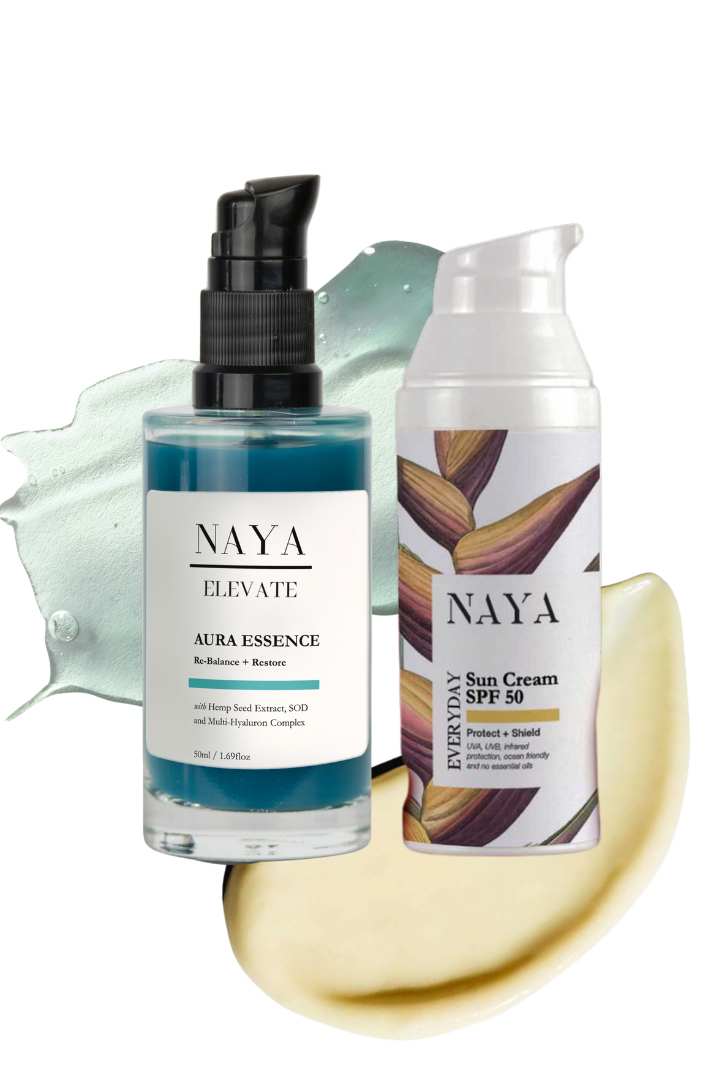Der Vergleich: Cacay-Öl oder Hagebuttenöl – Welches passt zu Deiner Hautpflege?
Cacay Oil vs Hagebuttenöl
Wir hoffen, du hast unsere ersten beiden Episoden unserer Mini-Serie genossen, in denen wir die Hautvorteile von Cacay Oil im Vergleich zu anderen hochwertigen Gesichtsölen auf dem Markt beleuchten. In der nächsten Episode schauen wir uns an: Cacay Oil vs Rosehip Oil.
In diesem Beitrag vergleichen wir Cacay Oil mit Hagebuttenöl und deren Vorteile für die Haut. Dies hilft dir dabei, herauszufinden, welches Öl am besten zu deinen Bedürfnissen passt. Lass uns mit einem Überblick beginnen.
Was ist Hagebuttenöl?
Bereits von den alten Ägyptern, Maya und Ureinwohnern Amerikas aufgrund seiner hautklärenden und heilenden Eigenschaften verwendet, ist Hagebuttenöl heute genauso beliebt wie vor Jahrhunderten. Es enthält Provitamin A (hauptsächlich Beta-Carotin) und Tretinoin (bis zu 0,357 ml/L) oder All-trans-Retinsäure. Dieses vielseitige Öl hält die Haut weich und geschmeidig, während es das Erscheinungsbild von Unreinheiten und Narben reduziert. Hagebuttenöl ist reich an Antioxidantien und wirkt somit auch als kraftvolles Anti-Aging-Mittel. In dieser Serie unserer „Cacay Oil vs“-Blogreihe werfen wir einen genaueren Blick auf dieses beruhigende Öl im Vergleich zu unserem hochwertigen Cacay Oil und seiner Verwendung in der Hautpflege.
Warum wird Hagebuttenöl in Hautpflegeprodukten verwendet?
Wie bereits erwähnt, enthält Hagebuttenöl Vitamin A, das für die abendliche Hautpflege hilfreich ist, um die Haut zu tonisieren und die Zellregeneration zu fördern, was für einen strahlenderen, helleren Teint sorgt. Es enthält auch essentielle Fettsäuren, die die Zellregeneration unterstützen, wodurch das Erscheinungsbild von Narben reduziert wird, und hält die Haut weich und geschmeidig. Es ist leicht und wird schnell aufgenommen (deshalb wird es oft als „trockenes Öl“ bezeichnet). Dieser Begriff „trockenes Öl“ kann jedoch sehr irreführend sein. Mehr dazu bald. Schließlich ist Hagebuttenöl ideal für alle Hauttypen.
Vergleich: Cacay Oil vs Hagebuttenöl
Cacay Oil ist das beste Geheimnis des Amazonas. Und es beginnt, unter einigen Beauty-Bloggern und Experten bekannt zu werden. Insgesamt bleibt Cacay Oil im Vergleich zu anderen Ölen wie Argan-, Marula- und Hagebuttenöl immer noch ein Beauty-Geheimtipp, wenn es um die #topshelfie-Gespräche geht.
Also, fangen wir an.
Was ist der Unterschied im Extraktionsprozess zwischen Cacay Oil und Hagebuttenöl?
Sowohl Hagebutte als auch Cacay sind in Südamerika beheimatet. Hagebuttenöl wird aus den Samen der Hagebutte (Rosa canina L.) gewonnen. Es enthält eine bemerkenswerte Anzahl von lipophilen Antioxidantien, insbesondere Tocopherole und Carotinoide. Hagebuttenöl enthält auch einen hohen Anteil an phenolischen Säuren, insbesondere p-Cumarsäuremethylester, Vanillin und Vanillinsäure. Aufgrund seiner hohen Zusammensetzung an ungesättigten Fettsäuren (UFAs) und Antioxidantien bietet dieses Öl einen relativ hohen Schutz gegen Entzündungen und oxidativen Stress. Shabikin et al. haben die Wirksamkeit von topischem Hagebuttenöl zusammen mit fettlöslichen Vitaminen bei verschiedenen entzündlichen Dermatitis-Erkrankungen wie Ekzemen, Neurodermitis und Cheilitis getestet, mit vielversprechenden Ergebnissen bei der topischen Anwendung von Hagebuttenöl bei diesen entzündlichen Hautkrankheiten.
Wie wird Hagebuttenöl produziert?
Hagebuttenöl stammt aus den Samen der leuchtend roten Hagebuttenfrucht bestimmter Rosensorten – Rosa aff. rubiginosa (auch Eglantine oder Hundsrose genannt) oder Rosa moschata (auch Moschusrose genannt), die beide in den südlichen Anden beheimatet sind. Das Öl kann auch aus den Hagebutten der Rosa canina (Hundsrose) gewonnen werden, die in Teilen Europas, Nordwestafrikas und Westasiens vorkommt. Hagebuttenöl ist berüchtigt schwer zu produzieren und muss von ausgebildeten Fachleuten verarbeitet werden. Daher variiert die Qualität von Hagebuttenöl zwischen den Marken erheblich. Die Samen der Hagebutte sind an dünnen Fransen befestigt, die bei Kontakt oder Einatmen in die Lunge gefährlich sein können. Nachdem die Samen vorsichtig entfernt wurden, durchlaufen sie einen komplexen Trocknungsprozess, bevor sie kalt gepresst werden, um das Öl zu extrahieren.
Linolsäure: Cacay Oil vs Hagebuttenöl
Zusammen mit Omega-3-Fettsäuren wird diese mächtige Omega-6 essentielle Fettsäure (EFA) oft als Vitamin F bezeichnet. Als EFA ist Linolsäure für die menschliche Gesundheit entscheidend, wird jedoch nicht natürlich im Körper produziert. Die topische Anwendung stärkt die Hautbarriere und hilft, uns vor UV-Strahlung und Umweltverschmutzung zu schützen, die beide schädliche freie Radikale aktivieren. Cacay Oil kann mehr als 70% Linolsäure enthalten. Du kannst die Ergebnisse unseres Öls auf unserer Wissenschaftsseite überprüfen. Aufgrund seines hohen Linolsäuregehalts ist es ein sehr gutes Öl für alle Hauttypen, einschließlich unreiner Haut oder Menschen, die unter Akne leiden. Jüngste Studien haben gezeigt, dass ein Mangel an Linolsäure eine Ursache für Unreinheiten oder Akne sein kann, da diese Säure hilft, Entzündungen zu reduzieren und die Poren zu befreien. Daher ist Cacay Oil aufgrund seines hohen Linolsäuregehalts für alle Hauttypen geeignet. Im Vergleich zu Hagebutte enthält Hagebuttenöl ebenfalls erhebliche ungesättigte Fettsäuren, wobei Linolsäure mit 35,9–54,8% am häufigsten vorkommt, jedoch immer noch deutlich weniger als in Cacay Oil.
Oleinsäure: Cacay Oil vs Hagebuttenöl
Oleinsäure ist reichhaltiger und führt bei Menschen mit akneanfälliger Haut häufig zu überschüssigem Öl. Linolsäure ist viel dünner und leichter, daher für Menschen mit fettiger oder akneanfälliger Haut geeignet. Oleinsäure (Omega 9) ist in Hagebuttenöl mit 14,7–22,1% etwas höher, während sie in Cacay bei etwa 10–14% liegt. Wenn du eher normale bis trockene Haut hast, kannst du Öle verwenden, die reich an Oleinsäure sind. Wenn du jedoch zu Mischhaut oder fettiger Haut neigst, solltest du Öle mit einem hohen Linolsäuregehalt wie unser Cacay Oil in Betracht ziehen.
Vitamin A: Cacay Oil vs Hagebuttenöl
Oft diskutiert, jedoch fehlt noch die Forschung, die bestätigt, dass Hagebuttenöl das bewiesene, Anti-Aging-antioxidative Vitamin A enthält. Vitamin A hilft, den Hautton zu ebnen und dunkle Flecken verblassen zu lassen, während es das Erscheinungsbild von Falten reduziert. Es hilft auch, einen trockenen, rauen Teint zu glätten. Während wir nachweisen können, dass Cacay Oil Vitamin A enthält, gibt es noch keine Forschung, die das Vorhandensein von Vitamin A in Hagebuttenöl bestätigt, obwohl Influencer und Marken, die Hagebuttenöl verkaufen, diese Behauptung ohne Beweise verbreiten. Kaufe also nicht dieses Öl wegen des angeblichen Vitamin A-Gehalts, da du enttäuscht sein könntest.
Retinol: Cacay Oil vs Hagebuttenöl
Im Vergleich enthält Cacay Öl Vitamin A, auch als Retinol bezeichnet. Wird es topisch angewendet, wandeln Enzyme in deiner Haut Retinol in Retinaldehyd und dann in Retinsäure um. Aufgrund der zweistufigen Umwandlung, die es durchlaufen muss, bevor die Haut es verwenden kann, ist Retinol natürlicherweise sanfter zur Haut. Daher ist Cacay Oil auch für empfindliche Haut geeignet. Es gibt Behauptungen, dass Hagebuttenöl All-trans-Retinsäure enthält. Wir konnten jedoch keine aktuellen Studien finden, die dies bestätigen. Stattdessen enthält Hagebutte Pro-Vitamin A oder Beta-Carotin, was die orange Farbe erklärt. Pro-Vitamin A oder Beta-Carotin ist ein Vorläufer von Vitamin A / Retinol.
Vitamin C: Cacay Oil vs Hagebuttenöl
Hagebuttenöl ist reich an Vitamin C und war lange ein Geheimtipp für Teeliebhaber. Allerdings wird Vitamin C im Fruchtfleisch und nicht in den Samen der Hagebutte gefunden. Da Hagebuttenöl kaltgepresst aus den Samen gewonnen wird, müssen die Behauptungen überprüft werden, ob in diesen Produkten überhaupt Vitamin C enthalten ist. Einige Forschungen haben jedoch gezeigt, dass je nach Herkunft des botanischen Produkts die Samen Spuren von Vitamin C enthalten können.
Fazit: Wie profitiert meine Haut von Hagebuttenöl vs Cacay Oil?
Hagebuttenöl hat viele Vorteile – zum Beispiel die Bekämpfung von Unreinheiten und Entzündungen – während Cacay Oil mit seinem hohen Gehalt an Linolsäure, Vitamin A und essentiellen Fettsäuren für alle Hauttypen bestens geeignet ist. Beide Öle sind einzigartige, kraftvolle Ergänzungen deiner Hautpflege. Wir empfehlen Cacay Oil jedoch als vielseitigere Option für deine Hautpflege-Routine, da es mehr nachgewiesene Vorteile bietet.













Hinterlasse einen Kommentar